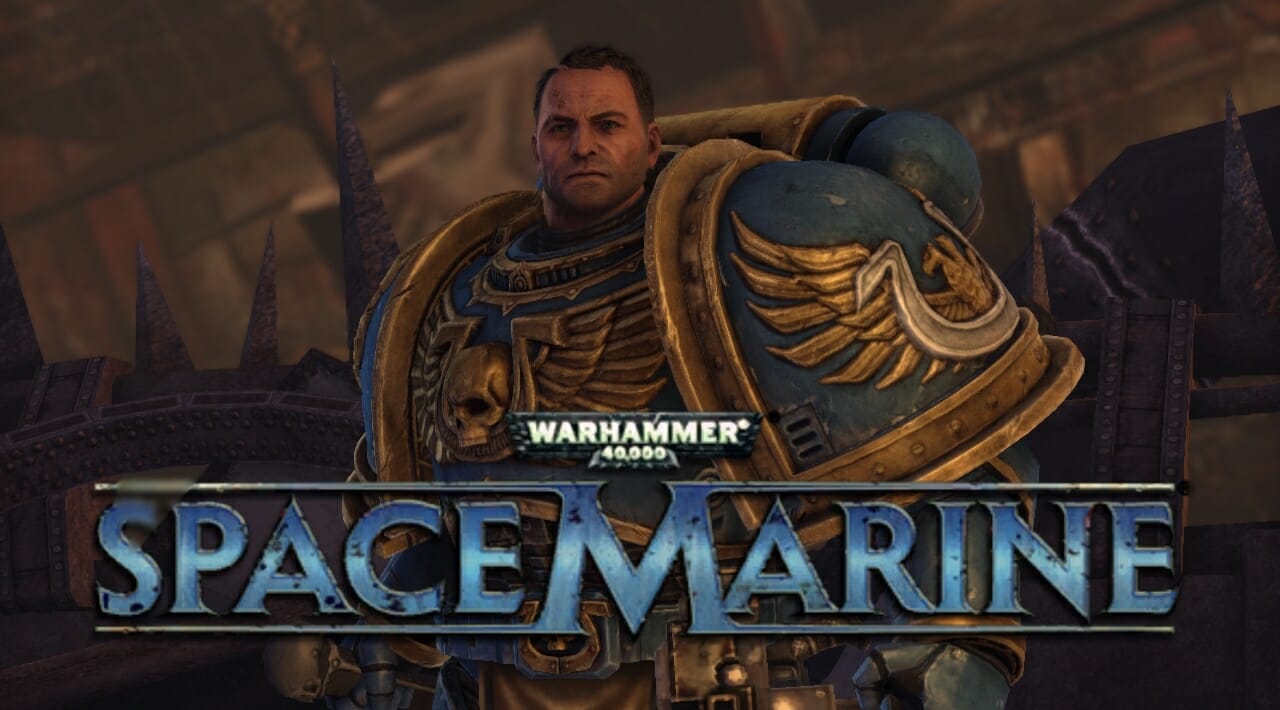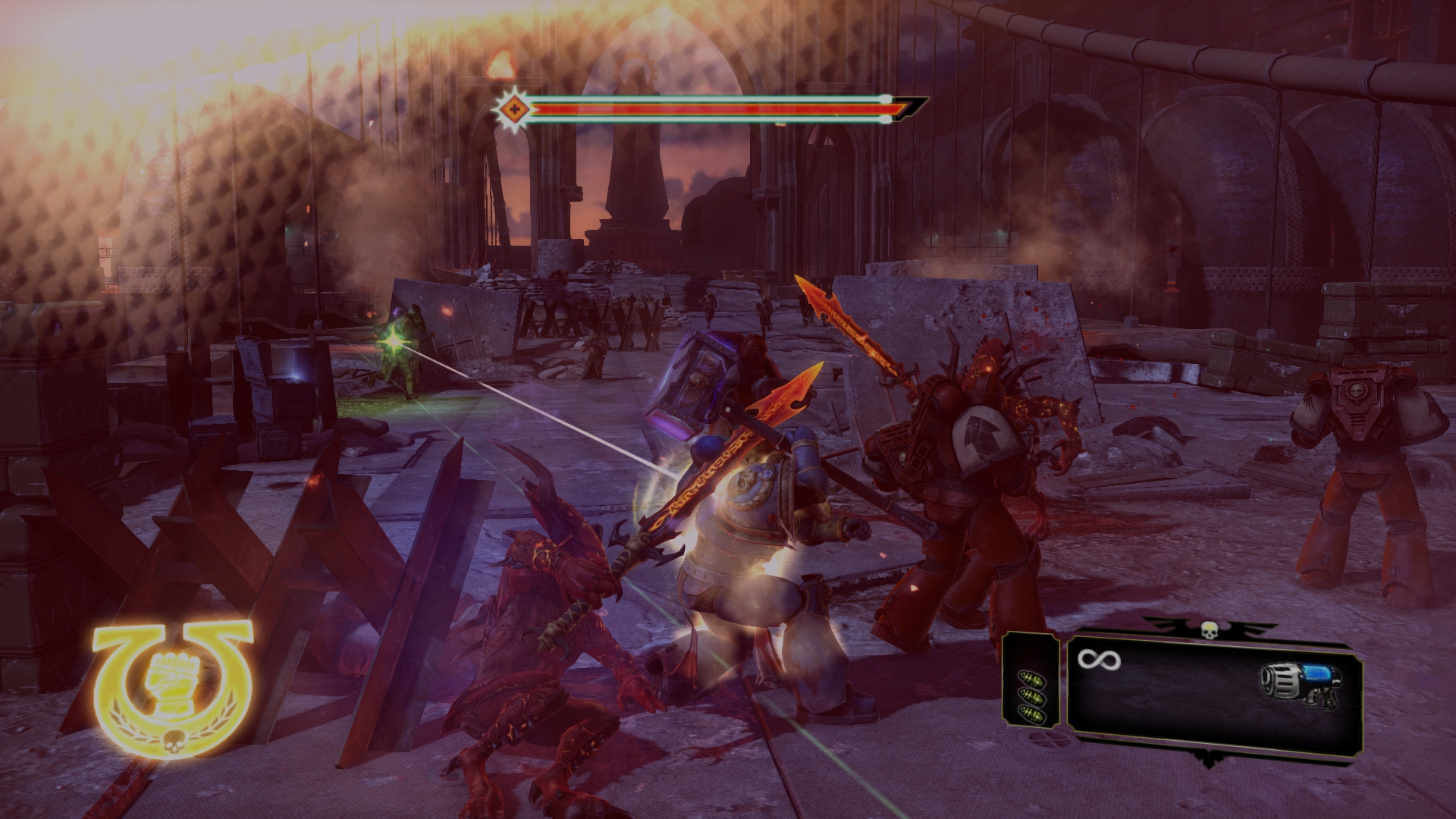
Two of the Emperor’s Space Marines review the new Space Marine training simulator.
IMPERIAL COMMUNIQUE #541170AX
VERMILION LEVEL CLEARANCE REQUIRED
TO: Chapter Librarian Varro Tigurius
FROM: Master of the Forge Fennias Maxim
SUBJECT: Space Marine Simulation Software
At our Lord Macragge’s request, two of our battle-brothers, Robert Zacarius and John Petraeus Grantae, have spent some weeks with the new Space Marine training software from the Adeptus Ludificatus at Reliquary. Brother Robert tested it using his Personal Cogitator, while Brother John Petraeus employed the X-Pattern 360-Degree system. For our archives, I present a transcript of their discussion. They have judged that Space Marine is a worthy depiction of the Adeptus Astartes’ service to the Emperor, but also an incomplete one that ultimately functions as a morale-boosting diversion.
Robert: I think we both agree, Brother, that the foremost consideration with any training aid is whether it sufficiently increases our faith in the Emperor and zeal for our sacred duty.
John: Indeed, we must ensure this is no idle pursuit; for heresy grows from idleness. To this end the software must engage trainees’ faculties with a compelling narrative. What say you of the simulation’s success in this regard, Brother?
Robert: I was pleased that Space Marine eschews fiction in favor of an historical campaign. It depicts the exploits of Ultramarine Captain Titus, whose deeds we have long studied, and his leadership of a small Marine squad during the Ork invasion of the Forge World Graia. When the simulation commences, the Orks have already overrun the Imperial Guard detachments defending the planet, and have almost gained control of powerful and perhaps even heretical experiments that could jeopardize the war effort in xenos hands. This is an excellent setting for a training aid. Brothers who have yet to taste battle will understand the pressures our Order so often endures.
John: It concerns me somewhat that initiates unfamiliar with our history, methods, and mission may feel overwhelmed by the specificity of this simulation’s portrayal. Yet I must commend it for thrusting the trainee into its world without resorting to tiresome exposition. Its characterization of the Space Marines is apt. It is particularly gratifying to see the Guardsmen, led by the courageous Lt. Mira, display the proper awe in the Ultramarines’ presence.

Robert: Doubtless, Space Marine will exclude as many prospective trainees as it indoctrinates. It is speciality equipment intended solely for the Emperor’s faithful, and I could not imagine recommending it to any who have not already heard His summons.
That said, there is drama to be had here. Many brothers will identify with the tension between our iron Order and Titus’ humanity. The Space Marines serve humanity but must stand apart from it, and I was much moved by Titus’ struggle to properly serve his several masters.
But of course, a simulation must also teach us how to thrive on the battlefield. I thought Space Marine rather mixed on this point. Were these your findings also?
John: The Design-Priests of Reliquary have captured the sense, if not the glory, of being an Astartes warrior. Titus, like any Space Marine worth his gene-seed, is a master of both bolter and chainsword, and gracefully combines marksmanship with melee. Their model of the Mark VII Armour takes advantage of these capabilities, as Captain Titus’ movements demonstrate the Space Marine’s unique combination of speed and power. Particularly enjoyable are the sequences in which Titus dons a jump pack and rains death upon the enemy from above, although these are regrettably few.
Unlike mortal soldiers — those mere cogs in the great Imperial machine — an Ultramarine does not seek cover in battle. Killing is our purpose and sustenance; and Space Marine models this a fury-meter that overflows with zeal as Titus slays enemies. Unleashing his rage with a furious burst of righteous devastation, Titus can slay dozens of enemies in a handful of hearbeats or seemingly slow time itself so that he can place each shot where it belongs: in the brain tissue of the Emperor’s enemies. It is fitting that Titus regains health by stunning, then executing the foul xenos and heretics: for, as any Astartes knows, nothing increases zeal like bathing in the blood of heretics and xenos. The glorious crunch of bone and the spray of gore as Titus crushes a greenskin’s skull beneath his boot are joys to behold. In this, the adepts of Reliquary have done our Chapter proud.
Their simulation provides trainees ample opportunity to experiment with a variety of Imperial arms, from mighty Thunder Hammers to deadly long-range Stalker Bolters. These are modeled with great fidelity, particularly in their sound and feeling. Yet I must note the lack of variety in combat scenarios. To be sure, the Design-Priests have created some impressive set pieces, including one memorable three-way battle between the Space Marines, the foul Orks, and the heretical forces of Chaos. Yet aside from the occasional appearance of an Ork Nob or shielded Chaos Space Marine, few situations present a challenge. The encounters quickly grow repetitive.

Robert: Yes. It was strange and most disappointing to find these closed, rote encounters in a simulation from Reliquary’s Design-Priests. I have long admired their Dawn of War tactical simulators for how well they model the diverse situations we must master. Space Marine ignores these lessons, to its and our peril.
John: Perhaps the most serious misstep in this simulation’s campaign mode is its insistence on funnelling the trainee through each stage, an approach that does not afford much opportunity for tactical creativity. Titus’ battle-brothers are competent soldiers, but the simulation does not permit you to deploy them in tactical manoeuvres, as any good Captain would. Fortunately, despite its flaws, the battle system they have constructed is enjoyable enough to support continued testing.
Robert: I must, however, denounce the emptiness and brutish simplicity of the simulation’s aesthetics. I have heard it said that in the grim darkness of our present, there is only war, but this is itself a heresy. The power of the Emperor and his servants light and glorify the universe, yet the Forge World of Graia is drab and crudely constructed. In my thousands of battles in the Dawn of War tactical simulators, and even in my observation of our tactical miniatures exercises, I have never seen so relentlessly ugly and unadorned a place as Graia. The greatest heresy in Space Marine is that it portrays an Imperial world that can only be improved by an Ork invasion.
John: Indeed. I regret to report that the squad training portion of the Space Marine simulation, which allows Astartes trainees to battle each other in teams of up to eight warriors, is similarly limited. Trainees may choose from three classes: the standard infantry Marine, the heavy support gunner, and the jump pack-equipped Assault Marine. The last is easily the most enjoyable role, as it affords greater freedom of movement.
While the combat training simulator contains well-designed (albeit deeply conventional) battelfields and performs admirably in connecting trainees remotely through the Immaterium, it offers only two scenarios. In Seize Ground, your team must claim and defend victory points, while in Annihilation, your squad must reach 41 kills before the enemy does.
Robert: I would also say that they have made efficient cooperation impossible with their terrible communications protocols. Space Marine leaves the vox channel open from every single Marine on the battlefield, meaning that I all I could hear was my compatriots’ exertions and the noise of their speakers. I was forced to do the unthinkable for a supposed tactical simulator: I muted all my comrades so that I could train without distraction. How is this to help us learn and employ tactics?

John: And that is the simulation’s most noticeable flaw. The joy of combat is deadened significantly without the ability to act in unison with your battle-brothers, slaying the xenos hordes as a unified squadron. The Design-Priests inform me that they will add a cooperative mode shortly, and I look forward to that addition, but remain concerned about Space Marine’s ability to compete with other combat simulators in the interim.
And why should our combat training exercises fall back on their overused, inefficient battle-schemes? Space Marine employs a system of unlockable wargear based on experience earned in battle. Before trainees can customize their warrior with their own Chapter colors — a prized activity in the Emperor’s service — they must reach Level 4. Worse yet, they do not gain access to specialized weaponry such as Melta Guns, Power Axes, and Lascannons until they have attained the proper rank.
Robert: This system goes too far in diminishing the role of individual skill. Higher-level trainees often seemed sloppy and arrogant in their tactics, but I was unable to punish them because their equipment was vastly superior. The outcomes were foreordained based on the amount of experience we have with the simulator, not on who employed better tactics or marksmanship.
FINAL JUDGEMENT AND RECOMMENDATIONS
We are given to understand that Space Marine is Reliquary’s first attempt at a personal combat simulator. They are to be commended for the excellent technical performance of their software, for their faithfulness to the magnificent and terrible glory of being a Space Marine in the Imperium of Man, and for their simulation’s success in engaging the trainee in what neophytes might call “fun.” Yet we are forced to conclude Space Marine contains several key flaws, including repetitiveness, linearity, and limited modes of operation. We wish the Design-Priests would have taken more risks.
Still, we recommend further investment in the Reliquary Simulator Manufactorum, as we believe this simulation, while imperfect, proves their ability to construct software worthy of the Emperor’s chosen. We earnestly await their next effort. Until then, Brothers, may the Emperor protect and guide you.
Warhammer 40,000: Space Marine was developed by Relic Entertainment and published by THQ. It is available for the Xbox 360, PS3, and PC.
Rob Zacny is a freelance writer living in Boston. He hosts the Three Moves Ahead strategy podcast, and compulsively reads the Warhammer wiki.
J.P. Grant is a Boston-based freelance writer whose work has appeared in Kill Screen, Gamers With Jobs, and other outlets. He blogs about games at http://infinitelag.blogspot.com and can be found on Twitter at @johnpetergrant.